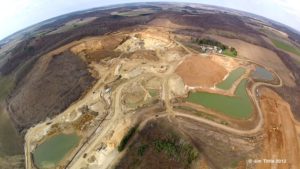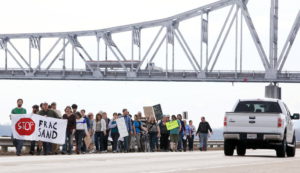
Fracking has been huge in the news in recent years. Stories of flammable water, earthquakes, global warming, poisoned water, gas leaks, and countless other instances of devastation have flooded the news. Concern regarding the sand mining that is used in fracking, however, has been largely out of sight in the media. When most of us think of fracking we think of gas and oil industries poisoning water and contributing to climate change, but sand mining has been quietly destroying farmland in America’s heartland for some time now.
Sand mining, a very important industry to fracking, has been endangering respiratory health, ground water, farmland, and the general well-being throughout the Midwest. Silica sand in particular is used by the fracking industry to prop open fissures deep underground allowing oil and gas to escape. The silica sand is known as “frac sand” or “proppant” by engineers and is hydraulically injected into the ground just as the proprietary chemical mixture that is also used in fracking.
Although there are many locations in the United States where sand is available, the states of Wisconsin, Minnesota and Illinois have seen considerable mining operations due to their large deposits of St. Peter Sandstone, also known as Ottawa white sand. These states are also targeted for mining because the sand is located just below the surface in wide bands. This type of silica sand is highly valued because of its durability, consistency and cheap price.
The sand mining operations cover huge areas of farmland and leave behind large dunes of soil and sand that can take years to return back to arable land. The silica that is dispersed into the air is a known carcinogen, but mining operations are currently exempt from regulation. While many wells are running dry, frac sand mining operations can use up to 2 million gallons of water per day with the low end estimate being well above 400 thousand gallons per day.
Many farmers in Illinois living on unincorporated land are being surrounded by these sand mines as local villages and towns have been annexing unincorporated land bought by private companies and removing any county imposed barriers to mining. LaSalle county in particular has seen about 3,100 acres bought since 2005. Many farmers are faced with the choice of selling their land or be surrounded by large mining pits and dunes.

As we have seen nationally, the oil and gas industry is a very short sighted endeavor. The mineral exploration companies, as well as their lackeys in government, often like to emphasize jobs that are created by their industry. What is never discussed by the frac sand industry is that once the boom of fracking is over, it is followed by a huge bust that leaves hundreds of people without a job. Many of these mining operations will only supply jobs in the dozens and only for a limited time for as long as the sand keeps pouring.
Of course, we should not expect the wealthy owners of the frac sand industry to care much about the future of the communities that they tear apart. We should understand that this is business as usual under our current economic system, capitalism. Under capitalism, companies with help from their friends in government, can buy land, have their friends in government annex the land, and draft laws limiting their liability to the community that is most impacted by their decisions.
The so-called leaders of this nation love to boast of democracy, freedom and liberty, but the mega-rich clearly have more access than others. The working class and poor people of this nation do not have a relationship with their government that allows them to annex homes to house their children, much less swaths of farmland that could feed their children. Throughout history, the people have had to struggle and suffer immensely to gain every single right to democracy, freedom and liberty. Many have died in these struggles, whereas the rich can simply purchase them.





